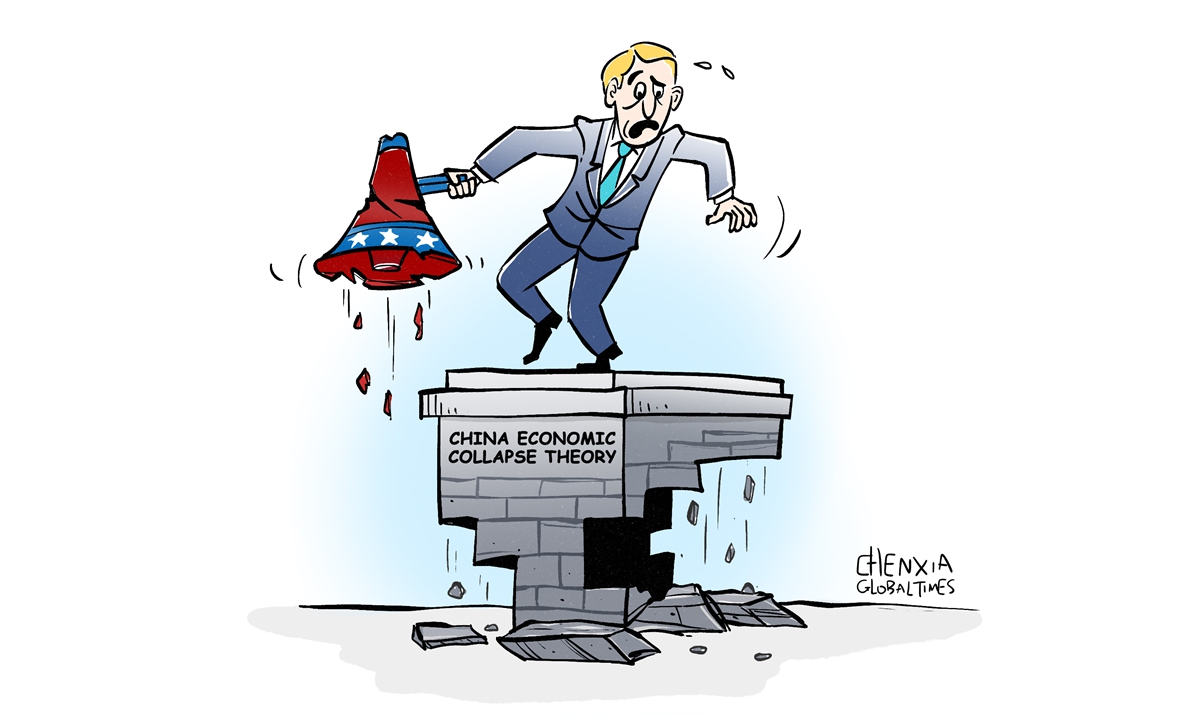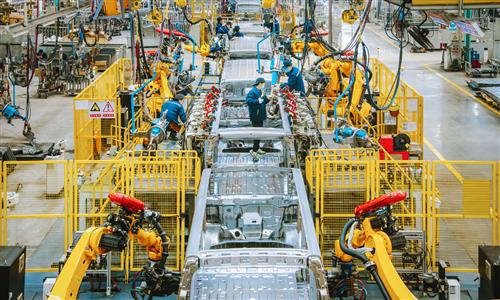
Illustration: Chen Xia/Global Times
After the National Bureau of Statistics recently reported major economic indicators, including yearly GDP growth, industrial output, consumer and factory prices, domestic retail and import and export volume, housing investment and demographic changes for 2023, some Western media pundits seem to be delving into narratives to prove that China's economy is in dire straits, "stumbling" or even "collapsing."The New York Times published an essay on Thursday entitled "China's Economy Is in Serious Trouble", authored by American economist Paul Krugman. In the article, he opined that Chinese economy "seems to be stumbling," with the announced official data showing that "China is experiencing Japan-style deflation," and "there's reason to believe that China is entering an era of stagnation and disappointment."
It is not the first time Krugman has decried the Chinese economy. In last August, he penned another opinion piece under the sensational headline "How Scary is China's Crisis?" in which he claimed that China "seems to be teetering on the edge of a crisis that looks a lot like what the rest of the world went through in 2008," pointing to the last global financial crisis triggered by the US' chaotic subprime debacle.
But the economic crisis that Western pundits like Krugman wrote or hoped for isn't happening in China at all. They have been spinning a story on a hypothetical crisis to engulf and tear down the world's emerging economic giant, and others are gloating over it. They will be disappointed again.
Actually, the strength of China's unique social system and the resilience of the Chinese economy, tested by the 1997 and 2008 financial crises and other events like the Biden administration's repulsive trade and technology war, should not be underestimated and denigrated by pundits. By all metrics, it is truly a great feat in human history to build a country as large as China from scratch in 1980 to its present size of nearly $18 trillion, or more in PPP (purchasing power parity) terms.
Official statistics revealed that the Chinese economy expanded by 5.2 percent in 2023 from the previous year to reach more than $17.5 trillion, as it rebounded from three years of anti-coronavirus control measures. Compared to merely 3.0 percent rise in 2022, the 5.2-percent growth last year is significant and impressive, obviously being one of the highest growths reported by the world's major economies.
As the single biggest engine of global economic growth, all of China's neighbors and trade partners, including those in Latin America, Africa and Europe, have become aware of the business opportunities created by China. With their factories, ranches and ports increasingly intertwined with China's, these partner economies are rapidly thriving. So it can be presumed that one of the untold reasons leading Western pundits to criticize China and its economy is to muddy the waters and plant seeds of doubt among China's major trade and economic partners.
US politicians have attempted to suppress China and hinder its growth by imposing high tariffs, sanctions, and restrictions on tech exports. They have also made attempts at "decoupling," which have been witnessed by the whole world in the past few years. However, those efforts have been unsuccessful. Now, pundits in the US media and academic circles want to support their politicians to go even harder at China, in their desperate hope to frighten away China's business partners and international investors interested in buying Chinese yuan-denominated assets and diversifying their investment portfolios to reduce their holdings of US dollar assets.
In his essay "How Scary is China's Crisis?" Krugman stated that China's government debts were "unsustainable," facing the "Minsky Moment" - meaning an impending implosion of the fiscal crisis. Many months have passed, yet the world hasn't seen a debt crisis in China.
Compared with the US government which added up to $7 trillion to its federal debts since the COVID pandemic to a total of more than $34 trillion, and it is running more than $1 trillion debt each year, China certainly is in a better fiscal shape. China has more than $3.2 trillion in foreign exchange reserve and has a very positive current account balance. Also, Chinese households' bank savings rate is much higher than their American counterparts. Correspondingly, China has more tools and means to accelerate economic stimulus over coming years to ramp up fiscal spending and cut savings rate to ramp up investment and inspire domestic consumption.
Chinese economists believe that the country has more room to maneuver to support government spending on a wide variety of projects and services, including rural infrastructure, urban utilities and amenities, technology innovations, expansion of manufacturing plants as well as improving its sprawling social safety net, including pension coverage for the retired people and better medical care for all newborns and other citizens.
Meanwhile, Chinese companies are rapidly catching up in research and development for new technologies. For example, the country is leading the world in producing clean renewable energies and exporting batteries, electric cars and other higher value-added products. Although China's urban housing sector is undergoing a correction after more than two decades of heated growth, the slowdown could be offset or mitigated by the boom in auto production and new-energy transformation.
As for the allegation that China "is entering an era of stagnation" similar to Japan's "Lost Two Decades," it is a preposterous assumption or Western pundits' wishful thinking about the Chinese economy. Any economist won't consider an economy with a trajectory of more than 5-percent annualized expansion to be falling into "stagnation." China's policymakers have the ability to issue more government bonds by raising the budget deficit ratio to 3.8 or 4 percent of GDP in 2024, which is still dwarfed by the US' 6.3 percent federal budget deficit ratio in 2023, to ratchet up economic activity and consumer prices. The policymakers' only concern is they don't want to leave a heavier burden on future generations.
When all of these factors are considered, there is no reason to be alarmed about China's growth. In comparison to the US, where the cost of living from housing rent to groceries to medication remains high, coupled with political infighting and dysfunction, China has a much more nimble decision-making system and can turn things around efficiently. American pundits, driven by ideology, have been predicting an imminent collapse of the Chinese economy since early this century, but so far, they haven't succeeded.
The author is an editor with the Global Times. bizopinion@globaltimes.com.cn



